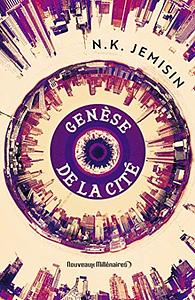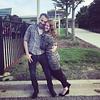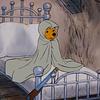You need to sign in or sign up before continuing.
Take a photo of a barcode or cover
Initial thoughts were:
1. This is a very weird concept
2. I do not know enough about NYC to grasp the intricacies at play here.
But still I was reeled in. I've read 2/3 of the Broken Earth trilogy, and NK Jemison is talented at making very complicated fantasy worlds feel inviting.
However, the momentum wained from about halfway through… I don’t feel enough of a plot existed here, and nothing really “happens” as such. It felt like it was more setting the stage for things to come, but I don’t know if I connected enough with any character, to continue this trilogy journey.
2.5/5
1. This is a very weird concept
2. I do not know enough about NYC to grasp the intricacies at play here.
But still I was reeled in. I've read 2/3 of the Broken Earth trilogy, and NK Jemison is talented at making very complicated fantasy worlds feel inviting.
However, the momentum wained from about halfway through… I don’t feel enough of a plot existed here, and nothing really “happens” as such. It felt like it was more setting the stage for things to come, but I don’t know if I connected enough with any character, to continue this trilogy journey.
2.5/5
adventurous
slow-paced
Diverse cast of characters:
Yes
This was decent, but there were a few parts that bothered me. What this book did best imo was being a response to Lovecraft racism/some of the racism in Lovecraftian horror. Like, I had already read The Ballad of Black Tom by Victor LaValle which was a “The Horror at Red Hook” by H.G. Lovecraft (which I also read), and I found it a bit unsatisfying because The Ballad of Black Tom focuses a lot on the experiences of Black Americans in 1920s New York, but a lot of the racism of Lovecraft's writing isn't about hating Black people in particular, it's about fear of racial mixing (and immigration comes with that). This is something that Jemisin did a much better job at because her book is about people of multiple races (some of whom are also immigrants) coming together, which is exactly what Lovecraft feared. But she also managed to make it make sense from a plot perspective (it's not just different races coming together, but New York coming together) and managed to integrate these fears with more modern forms of racism as well. I also think that The City We Became did a much better job with the subversion part of things, because it had the Lovecraftian horror be metaphorical white supremacy, where as The Ballad of Black Tom had the subversion be how even the Lovecraftian monsters are better than white racists, and empower Tommy by having him choose that, but it kind of backpedals and obscures that towards the end which didn't really work that well for me.
So like I previously mentioned, the antagonist of the story is white supremacy, and the book isn't particularly subtle about that. The villainous characters are white, and most of the sympathetic characters (and all of the most sympathetic characters) are people of color. I think this makes sense for a book about white supremacy, but I guess if you're hoping for a token good white character or a token evil PoC villain, there's not one here. I will say that Jemisin is really direct about these themes so if you tend to dislike that sort of directness and find it preachy, you're probably not going to have a great time with it.
One of the POVs (the one representing Staton Island) was a racist white woman, and while I don't have a problem with the idea of her character, the execution felt a bit off to me at times. Like, I can clearly see why Jemisin wrote her the way she did (daughter of a racist policeman because that'll be a good lead in to how white women are often taught to fear of other races, make her the victim of the patriarchy (her father) to make her a bit sympathetic, make her Irish-American because that's like the perceived underdog of white people while they still actually benefiting from white privilege, make her Catholic because religion can reinforce the patriarchy, etc). But all these aspects didn't really come together or always make sense to me. Probably the most glaring example of this was when Aislyn's mother just casually admits to having an abortion (makes sense from a white woman as victims of the patriarchy perspective (I think Jemisin was trying to make Aislyn and her mother seem more sympathetic to liberal readers), absolutely does not make sense from a devout/more traditional leaning Catholic perspective. Like yes, devout Catholic women have had abortions before, but I'd have a hard time imagining one that would treat it so casually, because that's seen as casually admitting to having murdered someone from a devout Catholic perspective. Even if she doesn't see it that way, she knows that a lot of the people around her will, which is why people don't casually talk about it.) Anyway, IDK if there were other little things in the other POVs (although the way Bronca referred to Two Spirit people felt a little odd to me at times, but I'm definitely not an authority on that topic).
Aislyn was also portrayed as being pretty stupid fortrusting the Woman in White so much. Which yeah, didn't really make sense to me either because it was portrayed like of course she'd trust a white woman. Can I see a racist white woman raised in a patriarchal family trusting another white woman over a random collection of POC people (the other POVs)? Sure. Can I see her trusting another white woman just in general as a friend without question even as that friend repeatedly talks about destroying the world while being really condescending? Definitely not, white women in those settings don't get along that well (the patriarchy doesn't exactly incentivize it), and you'd have to be really stupid to fall for that.
Aislyn was also portrayed as being pretty stupid for
The book is also has themes about sacrificing some people for other people, and I though that was handled inconsistently. When is people being killed for more people to survive ok? Like, universes of people die for cities, and in that case bigger number dying for smaller number is a good thing, but the borough avatars are supposed to be sacrificing themselves for the city (smaller number for bigger number is a good thing). Despite none of the avatars liking either of these ideas, no one pointed out that these are mutually incompatible/inconsistent, which I thought was odd.
Here's a lot of quick thoughts:
- Plotwise, the entire book was very much a getting the gang together, which did get kinda slow and annoying at times. That's not my favorite type of book.
- I can't say much about how accurately Jemisin portrays the different New York boroughs because I've never lived there.
- The magic was mostly fine, but Padmini had math superpowers which is a trope I dislike. Most of the main characters are at least a little unlikable at times, which I feel like is consistent with Jemisin's writing in general.
- I've seen reviews about other Jemisin books where people thought the way she handled queer men was weird, and yeah, I definitely saw that come across pretty clearly in this book (it felt kind of fetishizing? like not to a super obvious degree but definitely to the point were it felt uncomfortable to me).
- The audiobook was pretty interesting in that background sounds and music would occasionally be playing, which I liked (it felt a bit closer to an audiodrama). It wasn't really a full production thing, but I liked that touch.
Graphic: Hate crime, Racism, Sexual assault, Violence, Xenophobia, Toxic friendship, Classism
Moderate: Cursing, Death, Domestic abuse, Misogyny, Police brutality
Minor: Ableism, Addiction, Cancer, Homophobia, Panic attacks/disorders, Abortion, Alcohol, Deportation
A creatively written, multicultural sci-fi, which is the first novel I’ve read in the genre and will probably be my last. Not my cup of tea ☕️
adventurous
slow-paced
Plot or Character Driven:
Plot
Strong character development:
Yes
Loveable characters:
Yes
Diverse cast of characters:
Yes
Flaws of characters a main focus:
No
Very creative bit of fantasy/sci-fi - it was super slow to get through, but I enjoyed it overall. Looking forward to seeing where the next half of the story goes.
2.5 stars, I was pretty bored. Didn't feel like there was that much character development, rather it was character discovery. And the plot was quite slow. It's a beautiful love letter to New York, but doesn't have as much appeal from someone without deep connections to the city.
به غایت یکی از بدترین تجارب کتابخونی مربوط به ایده های خوب با پرداخت بد می شه. انگار یه معدن الماس باشه که الماس ها رو به عنوان سنگ های عادی حساب کنه. خیلی آثار دردناکی هستن، مخصوصا برای من. جسیمین با سه گانه زمین شکسته شناخته می شه. اون رو نخوندم اما ایده اون هم بسیار نابه ولی طبق شنیده ها، ایده زمین شکسته هدر نرفته.
شهری که ما شدیم راجع به آواتار های هر شهره. جلوه های انسانی هر شهر که ازش محافظت می کنن. ایده خیلی خوبیه ولی داستان نه. چطور؟ من الان کتاب رو تموم کردم و حقیقتش جز همین یک خط توضیحات ایده و دو سه خط چیزمیز دیگه هیچ اطلاعات درستی داده نمیشه. اوایل کتاب گفتم لابد جلوتر می گه ولی وقتی به نصف رسید فهمیدم نباید توقع توضیحات داشته باشم.هیچی نمیگه. تقریبا نصف کتاب اینجوری بودم:« ببین می فهمم چی میگی ولی متوجه نمی شم». جالب تر این که در حین همین بدبختی، جمیسین یه نوع روایت جدید رو امتحان کرده که قشنگ کومبو بزنه روی میزان درک من از داستان.
تبعیض نژادی و ظلم به جامعه الجیبیتی از موضوع هایی هستن که کتاب خیلی بهشون اشاره کرده. میگم اشاره چون پرداختی به اون صورت نداره. کاملا جدی و بدون شوخی، هرجایی که داستان کم اومده یه ترس از تبعیض جا داده. انگار پشت کله من رو گرفته بود و می کویند تو کتاب که «ببین چقدر می ترسن. ببین چقدر بدبختن. ببین چه بلایی سرشون میاد. می بینی؟!». یه جورایی شاید فقط می خواسته رده سنی کتاب بزرگسال بخوره. هیچکس نمی گه ظلمی نمیشه یا تبعیضی نیست ولی آخه اینطوری می خوای نشونش بدی؟ یه جاهایی بود که می خواستم بلند در برابر جمله هایی مثل «باید شانس بیاورد تا رنگ پوستش را نادیده بگیرند» داد بزنم:
به خدا فهمیدم! بسه
ولی ول نمی کرد که. همینقدر شعار زده ادامه میده میره جلو. جای باحالش اینجاست که همین عدم پرداخت و صرفا اشاره کردن متعدد باعث می شد این قضیه موضوع اصلی تری برای من باشه تا خود داستان و باز هم افسوس که اگر همه این اشارات رو جمع می کرد یک جا و یه چیزی مثل مورد اوایل کتاب می گذاشت، کاملا جواب می گرفت.
خود داستان هم که بسی meh بود
وقتی هم که تموم شد؛ گفتم خب من الان چیکار کنم؟
مثل میم مشهور رضا عطاران : تموم شد؟ خیلی تاثیرگذار بود
بدون هیچ چیز خاصی که کنجکاوی ایجاد کنه. شخصیت های کاغذی. روایت مبدا تا مقصدی و یکسری پرش عجیب. خودمونی بگم، چندین جا وسط داستان خیلی اتفاقات یهویی میوفتاد. یهو یه چیزی از زمین میومد بالا و شخصیت فرعی ها خیلی یهویی تصمیم می گرفتن که : "این چیز عجیبیه ولی اشکال نداره. می ذارم دوستام که راجع به یسری موضوع که هیچی ازشون نمی فهمم صحبت می کنن قضیه رو حل کنن و من هم مثل هیچ انسان عادی و سالمی عمل نمی کنم و تصمیم می گیرم که نمی ترسم. اون هم از یسری هشت پا که از زمین بیرون زدن. کاملا عادیه برام. هر روز با این چیزها رو به رو می شم"
امیدوارم منظورم رو رسونده باشم.
طولانیش نکنم. شهری که ما شدیم رو پیشنهاد نمی کنم. نه واقعا. اگر فانتزی شهری می خواید برید سراغ کنستانتین یا نایت ساید یا حتی ابزار فانی. حالا که فکرش رو می کنم، اوه پسر ابزار از این خیلی بهتره.
محفل نهم هم بخونید راستی.
آره خلاصه. برید اولویت فانتزی شهریتون رو روی اون ها بذارید نه این
مرسی که خوندی
پن : اگر زمانی تصمیم بر این گرفتید که کتاب رو بخونید؛ باید از قبل یه آشنایی سطحی با خیابون ها،مکان ها و محله های مشهور نیویورک داشته باشید. اکثرشون رو شاید از توی فیلم و سریال ها بشناسید ولی باز هم چندتایی برای من جدید بودن و سرچ کردم. جدای از اون هیچ فضاسازیای از خود نیویورک بهتون نمیده باید توی عکس و فیلم ها آشنایی داشته باشید.
شهری که ما شدیم راجع به آواتار های هر شهره. جلوه های انسانی هر شهر که ازش محافظت می کنن. ایده خیلی خوبیه ولی داستان نه. چطور؟ من الان کتاب رو تموم کردم و حقیقتش جز همین یک خط توضیحات ایده و دو سه خط چیزمیز دیگه هیچ اطلاعات درستی داده نمیشه. اوایل کتاب گفتم لابد جلوتر می گه ولی وقتی به نصف رسید فهمیدم نباید توقع توضیحات داشته باشم.هیچی نمیگه. تقریبا نصف کتاب اینجوری بودم:« ببین می فهمم چی میگی ولی متوجه نمی شم». جالب تر این که در حین همین بدبختی، جمیسین یه نوع روایت جدید رو امتحان کرده که قشنگ کومبو بزنه روی میزان درک من از داستان.
تبعیض نژادی و ظلم به جامعه الجیبیتی از موضوع هایی هستن که کتاب خیلی بهشون اشاره کرده. میگم اشاره چون پرداختی به اون صورت نداره. کاملا جدی و بدون شوخی، هرجایی که داستان کم اومده یه ترس از تبعیض جا داده. انگار پشت کله من رو گرفته بود و می کویند تو کتاب که «ببین چقدر می ترسن. ببین چقدر بدبختن. ببین چه بلایی سرشون میاد. می بینی؟!». یه جورایی شاید فقط می خواسته رده سنی کتاب بزرگسال بخوره. هیچکس نمی گه ظلمی نمیشه یا تبعیضی نیست ولی آخه اینطوری می خوای نشونش بدی؟ یه جاهایی بود که می خواستم بلند در برابر جمله هایی مثل «باید شانس بیاورد تا رنگ پوستش را نادیده بگیرند» داد بزنم:
به خدا فهمیدم! بسه
ولی ول نمی کرد که. همینقدر شعار زده ادامه میده میره جلو. جای باحالش اینجاست که همین عدم پرداخت و صرفا اشاره کردن متعدد باعث می شد این قضیه موضوع اصلی تری برای من باشه تا خود داستان و باز هم افسوس که اگر همه این اشارات رو جمع می کرد یک جا و یه چیزی مثل مورد اوایل کتاب می گذاشت، کاملا جواب می گرفت.
خود داستان هم که بسی meh بود
وقتی هم که تموم شد؛ گفتم خب من الان چیکار کنم؟
مثل میم مشهور رضا عطاران : تموم شد؟ خیلی تاثیرگذار بود
بدون هیچ چیز خاصی که کنجکاوی ایجاد کنه. شخصیت های کاغذی. روایت مبدا تا مقصدی و یکسری پرش عجیب. خودمونی بگم، چندین جا وسط داستان خیلی اتفاقات یهویی میوفتاد. یهو یه چیزی از زمین میومد بالا و شخصیت فرعی ها خیلی یهویی تصمیم می گرفتن که : "این چیز عجیبیه ولی اشکال نداره. می ذارم دوستام که راجع به یسری موضوع که هیچی ازشون نمی فهمم صحبت می کنن قضیه رو حل کنن و من هم مثل هیچ انسان عادی و سالمی عمل نمی کنم و تصمیم می گیرم که نمی ترسم. اون هم از یسری هشت پا که از زمین بیرون زدن. کاملا عادیه برام. هر روز با این چیزها رو به رو می شم"
امیدوارم منظورم رو رسونده باشم.
طولانیش نکنم. شهری که ما شدیم رو پیشنهاد نمی کنم. نه واقعا. اگر فانتزی شهری می خواید برید سراغ کنستانتین یا نایت ساید یا حتی ابزار فانی. حالا که فکرش رو می کنم، اوه پسر ابزار از این خیلی بهتره.
محفل نهم هم بخونید راستی.
آره خلاصه. برید اولویت فانتزی شهریتون رو روی اون ها بذارید نه این
مرسی که خوندی
پن : اگر زمانی تصمیم بر این گرفتید که کتاب رو بخونید؛ باید از قبل یه آشنایی سطحی با خیابون ها،مکان ها و محله های مشهور نیویورک داشته باشید. اکثرشون رو شاید از توی فیلم و سریال ها بشناسید ولی باز هم چندتایی برای من جدید بودن و سرچ کردم. جدای از اون هیچ فضاسازیای از خود نیویورک بهتون نمیده باید توی عکس و فیلم ها آشنایی داشته باشید.
adventurous
challenging
hopeful
inspiring
reflective
medium-paced
Plot or Character Driven:
A mix
Strong character development:
Complicated
Loveable characters:
Yes
Diverse cast of characters:
Yes
Flaws of characters a main focus:
Complicated
adventurous
challenging
hopeful
slow-paced
Plot or Character Driven:
A mix
Strong character development:
No
Loveable characters:
Yes
Diverse cast of characters:
Yes
Flaws of characters a main focus:
No
Too complicated and too slow. Don’t think I’ll read the other books in the trilogy. Couldn’t get into it, the plotting was too fractured.
adventurous
funny
fast-paced
Plot or Character Driven:
A mix
Loveable characters:
Yes
Diverse cast of characters:
Yes
Flaws of characters a main focus:
Yes
challenging
hopeful
reflective
medium-paced
Plot or Character Driven:
A mix
Strong character development:
Complicated
Loveable characters:
Complicated
Diverse cast of characters:
Yes
Flaws of characters a main focus:
Yes





